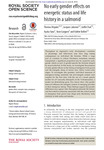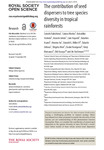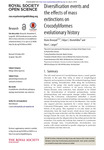Search
Now showing items 1-10 of 49
No early gender effects on energetic status and life history in a salmonid
(2015)
Throughout an organism’s early development, variations in physiology and behaviours may have long lasting consequences on individual life histories. While a large part of variation in critical life-history transitions ...
Omura’s whales off northwest Madagascar
(2015)
The Omura’s whale (Balaenoptera omurai)was describedas a new species in 2003 and then soon after as an ancient lineage basal to a Bryde’s/sei whale clade. Currently known only from whaling and stranding specimens primarily ...
The contribution of seed dispersers to tree species diversity in tropical rainforests
(2015)
Tropical rainforests are known for their extreme biodiversity, posing a challenging problem in tropical ecology. Many hypotheses have been proposed to explain the diversity of tree species, yet our understanding of this ...
How the zebra got its stripes
(2015)
The adaptive significance of zebra stripes has thus far eluded understanding. Many explanations have been suggested, including social cohesion, thermoregulation, predation evasion and avoidance of biting flies. Identifying ...
Back to Tanganyika
(2015)
The species flocks of cichlid fishes in the East African Great Lakes are the largest vertebrate adaptive radiations in the world and illustrious textbook examples of convergent evolution between independent species ...
Regional differentiation and extensive hybridization between mitochondrial clades of the Southern Ocean giant sea spider Colossendeis megalonyx
(2015)
Assessing the enormous diversity of Southern Ocean benthic species and their evolutionary histories is a central task in the era of global climate change. Based on mitochondrial markers, it was recently suggested that the ...
Diversification events and the effects of mass extinctions on Crocodyliformes evolutionary history
(2015)
The rich fossil record of Crocodyliformes shows a much greater diversity in the past than today in terms of morphological disparity and occupation of niches. We conducted topology-based analyses seeking diversification ...
Highly contrasted responses of Mediterranean octocorals to climate change along a depth gradient
(2015)
Climate change has a strong impact on marine ecosystems, including temperate species. Analysing the diversity of thermotolerance levels within species along with their genetic structure enables a better understanding of ...
Dramatic niche shifts and morphological change in two insular bird species
(2015)
Colonizations of islands are often associated with rapid morphological divergence. We present two previously unrecog-nized cases of dramatic morphological change and niche shifts in connection with colonization of tropical ...
New evidence on the tool assisted hunting exhibited by chimpanzees
(2015)
For anthropologists, meat eating by primates like chimpanzees (Pan troglodytes) warrants examination given the emphasis on hunting in human evolutionary history. As referential models, apes provide insight into the evolution ...










